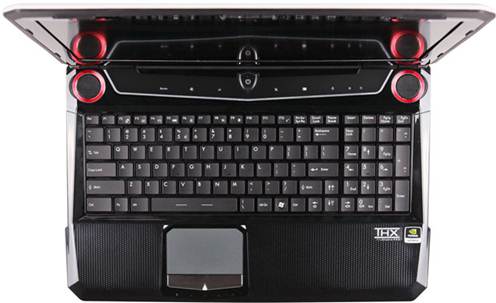After reviewing the iBuyPower CZ-17 last month and seeing it
look nearly identical to our zero-point MSI GT60, we were hoping our next
gaming laptop would be a fresh, new design. Unfortunately, Maingear’s Normal 15
apparently uses the same original design manufacturer (ODM) construction as
those other two.

Maingear Nomad 15
This isn’t to say the 15.6-inch laptop is ugly. It’s just
that when you’re paying $2,600 for a device, you’d like to get something that
looks cool and original. The 14.9x10.2x1.7-inch chassis and nearly eight-pound
body is roughly the same size/ weight as the MSI GT60 and features the same
geometric contours and cut-off corners. Its keyboard features the exact same
faint, blue backlit-LED keyboard as the CZ-17.

To be fair, Maigear does add some small tweaks to the ODM
design: The laptop cover comes in a wide variety of colors (we got our in
blue), the palm-rest area is textured with a pattern of small hexagons, and the
body has surprisingly good job of keeping fingerprints at bay. Another nice
aspect of laptop is its screen. The matte 1920x1080 resolution monitor does a
great job of minimizing the annoying TN-shimmer commonplace on cheaper screens,
and off-axis viewing is surprisingly good.
While the monitor is nice, it’s what’s under the hold that
really shines. Our Nomad 15 came loaded with impressive specs: a 2.8GHz Intel
Core i7-3840QM processor, 16GB of DDR3/1600, and a GeForce GTX 680M. It clearly
beat the GT60 zero-point in nearly every one of our performance benchmarks. The
closest our zero-point got to the Nomad 15 was in the CPU intensive tests
(Stich, Pro-Show, and x264 HD 5.0), but even here the GT60 was still behind by
at least 10 percent in all test. In the GPU-intensive applications, Maingear’s
laptop really blew our zero-point out of the water. The Normal 15’s GeForce GTX
680 annihilated the GT60’s GTX 670M by 210 percent in our STALKER benchmark.
The gap only widened when we ran 3DMark 11, where Maingear’s laptop slaughtered
the GT60 by 242 percent. These tests only confirm that a 680M with its new 28mm
Kepler architecture is that much more efficient than 670M with its older Fermi
design.

In our experiential gameplay tests, the Nomad 15 didn’t
break a sweat running Source-engine games like Dote 2 maxed out – it had no
problems staying above 70fps. We pressed on and installed Far Cry 3, a shooter
that’s known to make even the fastest desktop GPUs cry (pun intended). While
the Nomad 15 didn’t come close to maxing out the graphically intensive game, it
was able to stay consistently above 40fps on “high” setting at 1080p.
Conversely, on the same settings, our zero-point couldn’t even break 30fps.

Boot times on the Nomad 15 were also good. Armed with a pair
of Crucial M4 128GB SSDs the Nomad 15 booted to Windows in 24 seconds. Our
SSD-less zero point took more than twice as long. The only area where Maingear’s
offering fell behind the zero point was in battery life but by just 10 percent
in video playback. It appears that all that power has to take a toll somewhere.
When you’re spending a premium for a gaming laptop, you
might expect a unique, beautifully designed chassis. You’re not getting that
here. What you’re paying for is brute-force performance, and what a beast of a
performer this Nomad 15 is.
Verdict Maingear Nomad 15: 9
+ Nomad: Killer performance; nice monitor.
- Hermit: Unoriginal design; expensive.
Our zero-point notebook is an MSI GT60 with a 2.3GHz Intel
Core i7-3610QM, 12GB DDR3/1600, two 500GB Seagate 7,200rpm hard drives, a
GeForce GTX 670M, and Windows 7 Home Premium 64-bit STALKER CoP tested at
1920x1080 with Ultra settings, Tessellation, and contact hardening.
|
Info
§ Price: $2,600
§ Website: www.maingear.com
Specifications
§ CPU: 2.8HZ Intel
Core i7-3840QM
§ RAM: 16GB DDR3/1
600
§ Chipset: Intel HM77
§ GPU: Nvidia GeForce
GTX 680M 4GB GDDR5
§ Display 15.6-inch,
1920x1080 LED display (glossy)
§ Storage: 2x 128GB
SSDs; 750GB HDD
§ Optical Drive: 8x
DVD burner
§ Connectivity:
Ethernet, VGA, HDMI, eSATA, all-in-one USB 2.0 flash card reader, 3x USB 3.0,
2x USB 2.0, audio in, audio out, headphone, mic, 2MP webcam, Bluetooth,
802.11n
§ Lap/ Carry: 7lbs,
7.3 oz/ 9 lbs, 10.6 oz
Verdict
§ Stitch.efx 2.0
(sec): 917 (11%), zero-point: 1,092
§ Proshow Producer 5
(sec): 1,540 (16%), zero-point: 1,786
§ X264 HD 5.0 (fps):
13.4 (12%), zero-point: 12
§ STLKER: CoP (fps):
69.1 (210.7%), zero-point: 32.8
§ 3DMark 11 Perf:
7,122 (242.1%), zero-point 2,979
§ Battery Life (min):
170 (-9.1%), zero-point: 187
|